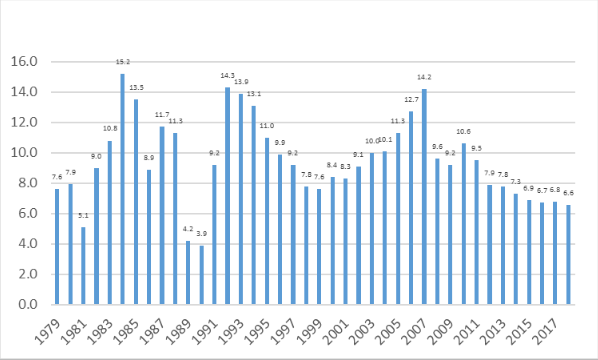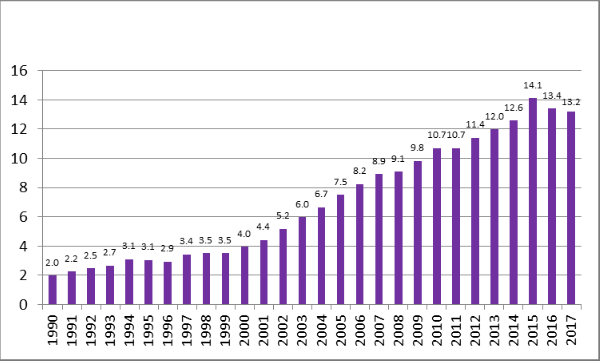Global trade refers to the transfer of goods and services across international boundaries. Trading across borders has existed for long with historical accounts revealing that humans depended on trading to acquire the commodities necessary for life. Ancient international trade occurred between kingdoms, and individual merchants controlled the transactions. The traded products often served wealthy people because the poor relied on agricultural produce and local suppliers. Traders of luxury items relied on several chains of brokers to transport goods across vast distances due to limited means of transport. Most of the ancient kingdoms that promoted trade have since become extinct. However, some have evolved into present-day nations including the United Kingdom, China, India, and other European countries. From the mid-20th century, China’s economy expanded rapidly, leading to increased participation in global trade. The country is an essential driver of global business and continues to shape the growth of international trade.
History of International Trade
The Middle East served as the center of global civilization for an extended period beginning from 3000BC. The region recorded intense trading activities between the Egyptians, Phoenicians, and other kingdoms near the Mediterranean Sea (Vanham, 2019). From the 1st century B.C., China and India began to participate in the trade by supplying spices and silk clothing along the Silk Road (Vanham, 2019). The Silk Road started at the present-day city of Xi’an in China and extended across the Asian continent to Europe (Vanham, 2019). However, the collapse of Rome led to the demise of the Silk Road, and trade routes shifted to other regions. Asia became the center of global economic activity after the end of the Roman empire. From the 7th to the 15th century, Arab traders controlled the trade routes along the ancient Silk Road and acted as middlemen between Asia and Europe. The Arabs were the undisputed leaders of the trade, primarily supplying spices such as cloves, nutmeg, and mace (Vanham, 2019). Lastly, the group operated as intermediaries who controlled most of the trading activities. In the 14th century, European explorers such as Vasco Da Gama pioneered a new trade route around the coast of Africa to Asia. The sea route opened the doors for increased trade between Europe and Asia and also led to the discovery of America (Vanham, 2019). New crops such as coffee, potatoes, and tomatoes began to replace spices as an essential trading item.
Industrialization took off after the invention of the steam engine and other technologies. European nations and the United States gained an advantage over China and India in global trade. From the 19th century to the 20th century, economic thinkers such as Adam Smith, David Ricardo, and James Mill began to influence global thought on trade. The economists proposed various theories and policies that shaped how countries conducted business. Ricardo’s theory of comparative advantage postulated that a state could produce some goods more cheaply than other countries (Cohn, 2016). Therefore, a country with a comparative advantage on a particular item could focus on making the product and allow other nations to deliver the products for which they had a comparative advantage. However, other economists proved that comparative advantage was a product of many factors, such as capital and natural resources. The theory of comparative advantage served as a catalyst for global trading at the time. According to Cohn (2016), the theory explains that trading is beneficial even if countries do not gain an absolute advantage. Adam Smith and other economists brought the age of trade regulation on the world after centuries of free-market trade.
Western nations adopted various rules and advanced technologies that gave them an edge over China (Vanham, 2019). In addition, China lacked the technological capacity and administrative structures to jumpstart its growth. However, the World Wars reset the advantages that western nations enjoyed. After World War II, increased economic cooperation ensured. Global organizations emerged that began providing oversight on global trading activities. The organizations encouraged countries to sign treaties for economic collaboration to boost trading. Several nations led by the United States signed the General Agreement on Tariffs and Trade (GATT) in 1947 (Cohn, 2016). The GATT was a plan to remove protectionism measures of the interwar period that negatively affected global trade. The signing of the agreement led to a reduction of tariffs on imports.
In the mid-20th century, China began to open its economy and lift restrictions on production activities. The shift to a free-market approach opened China’s manufacturing sector and the agricultural sector. Economic output increased exponentially, and the country took on a path for economic transformation. Historically, China had been a global power, but poor leadership and inefficient policies between the 18-20th centuries led to poverty and isolation from global trading (Congressional Research Service, 2019). From 1979, China began to record sustained economic growth following a series of economic reforms. The country’s Gross Domestic Product (GDP) has doubled every eight years since 1979. China is now the manufacturing center of the world and has recently launched a plan to revive the Silk Road through a program called Belt and Road Initiative (Vanham, 2019). China now enjoys a key position as a driver of global exports through extensive manufacturing. Manufacturing accounted for 28.7% of China’s GDP in 2016. However, China is shifting its focus from exports to consumption, services, and innovation (Congressional Research Service, 2019). The strategy is a way of enhancing the local market and reducing dependence on foreign nations.
Growth of Chinese Economy and the Effect on Global Trade
Since 1979, China’s economy has grown exponentially. The chart below illustrates the fast-paced growth of the country in the last four decades.

China has been going through an exciting period of transformative growth in the last decades. Lin and Wang (2008) explain that China has succeeded because of the ability to learn, adapt, and upgrade industrial capacity. Learning has involved prioritizing the economic activities that lie within the country’s comparative advantage. The approach has enabled China to trade with countries that do not have similar benefits and also those with similar capacities. According to Lin and Wang (2008), China has been a keen learner, expertly observing the developed and developing nations and engaging the countries through different strategies. Besides, China liberalized commodity prices and removed investment barriers to allow foreign and local firms to invest in the manufacturing sector. The firms followed their comparative advantages to position themselves in crucial areas of the manufacturing industry. The country also engaged in large-scale manufacturing upgrades by utilizing expertise from the Western World and importation of machinery. In general, China’s growth is attributable to capital investments and productivity growth.
Due to expansive manufacturing, China’s proportion of the global export market has risen steadily. According to the Congressional Research Service (2019), China’s share of the World GDP grew from 2.3% in 1980 to 18.3% in 2013, indicating that the country has become an essential driver of the global economy through trade. The trade levels between China and the USA grew from $5 billion in 1980 to $ 660 billion in 2018 (Congressional Research Service, 2019). China now serves a significant position in the USA market. The Congressional Research Service (2019), also reports that Chinese merchandise exports increased from $14 billion in 1979 to $2.5 trillion in 2018, while imports increased from $18 billion to $2.1 trillion in the same period. The data shows that China is a significant contributor to international trade. As of 2013, China was the largest trading partner for over 130 nations in the world, further highlighting the significant contribution of China to global business.
The chart below illustrates China’s rising share in global merchandise exports from 1990 to 2017.

Chinese exports consist of electronics and electrical equipment, machinery, furniture, plastic, and vehicles. Foreign companies based in China contribute to a significant proportion of exports. International firms prefer to base their operations in China due to the low cost of production. China is not only the largest manufacturer of the world but also a leading financier of governments around the globe. China has been financing various government budgets and projects. The financing spurs global trade between the lender and the borrowers.
Criticism
China’s growth has not been without criticism since the USA congress has, at various times, accused the Chinese government of employing unfair trading practices such as undervaluing its currency to boost exports (Congressional Research Service, 2019). Other accusations include the adoption of policies that favor local firms at the expense of international companies and failing to protect the intellectual property rights of other nations.
Risks to the Chinese Economy
Although the Chinese economy is expanding, some risk factors can derail economic progress. The factors include rising environmental pollution, increasing debt, trade wars, and a working population that is aging (Lin & Wang, 2008). Other current risks include trade wars with the USA and the COVID-19 pandemic. Environmental pollution is a leading cause of diseases that can significantly reduce the output of labor and also increase health expenditures. Diversion of finances from development to healthcare reduces the pace of economic growth. Trade wars and the current pandemic have the potential to slow manufacturing, which will slow global economic growth. Any significant shocks on the Chinese economy will have adverse effects on the world that is increasingly reliant on Chinese manufacturing prowess.
Conclusion
China has been a driver of international business historically and continues to contribute immensely to the growth of international trade. Since the 1st century B.C. to the 21st century, China has supplied goods to the world without fail. The country has traditionally relied on her large population and comparative advantages to mass-produce products for the international market. The presence of a large workforce, capital, and natural resources give China a competitive advantage in manufacturing. Although the West invents much of the manufacturing technology, China adopts those technologies to foster productivity. The ability to learn, adapt, and upgrade is a part of the country’s uniqueness that consistently places it at the top of world manufacturing. China has been able to outpace India, which has a similar population, to remain as Asia’s center of production. China has also outpaced Japan in manufacturing.
The contribution of China to Global trade consists of manufactured products, financial services, construction, and military support. The country is also diversifying into technology innovations to drive growth in this decade. The diversity of economic activities places the country on a firm platform for exponential growth in the next decades. As the pace of globalization gathers pace, China will likely continue to gain a more significant contribution to global trade.
Developing nations have much to learn from China in their quest to increase their participation in international business. Most developing countries have particular comparative advantages in agriculture, services, and manufacturing they can utilize to achieve economic growth. Every nation should work towards improving the state of the global trade by applying favorable economic policies, providing goods and services, and consuming what other countries produce. The developed nations should also note the shift in global power from the West to the east and act accordingly. Western governments should drop imperialist approaches in international trade and instead adopt mechanisms that accrue mutual benefits for the developing countries. Such strategies will help developing nations to grow faster as well as offer opportunities for the developed countries to expand their trading revenues.
References
Cohn, T. (2016). Global political economy: Theory and practice. Routledge.
Congressional Research Service. (2019). China’s economic rise: History, trends, challenges, and implications for the United States. Federation of American Scientists. Web.
Lin, J., & Wang, Y. (2008). China’s integration with the world: Development as a process of learning and industrial upgrading. World Bank. Web.
Vanham, P. (2019). A brief history of globalization. World Economic Forum. Web.
